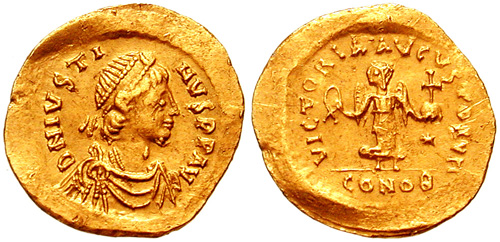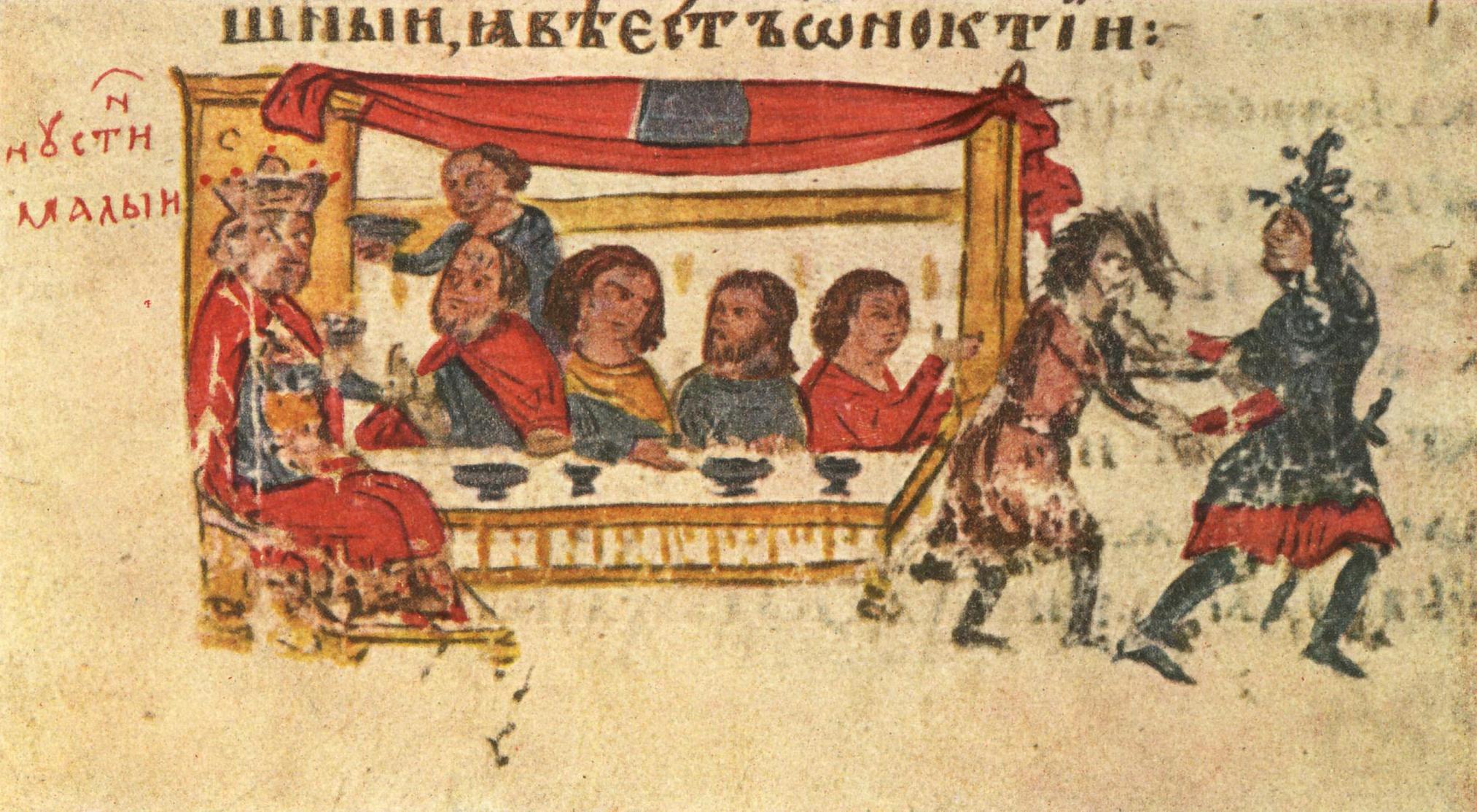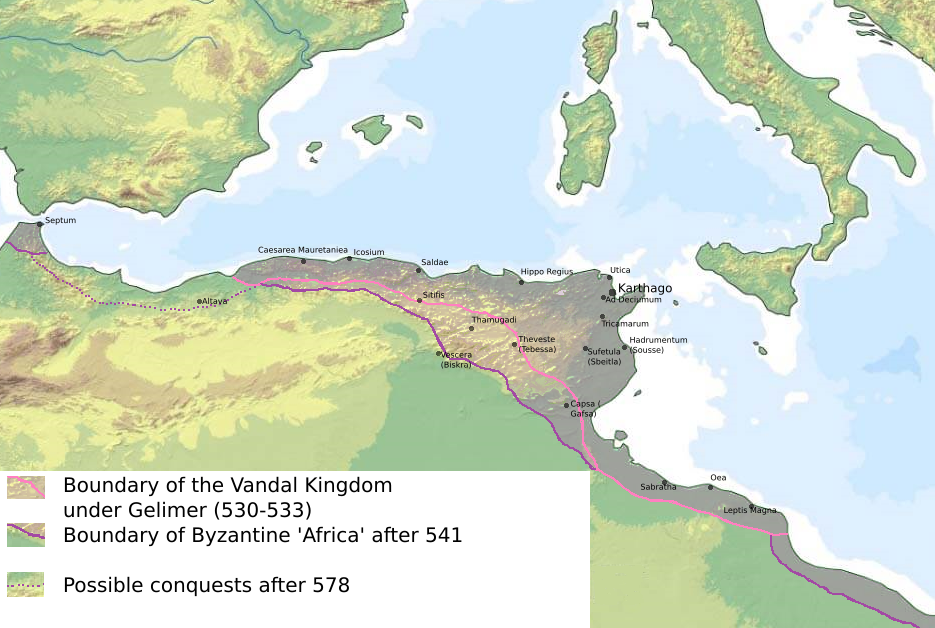|
Praejecta
Praejecta or Praiecta was a niece to Byzantine emperor Justinian I (r. 527–565) by blood and of his empress Theodora by marriage. Biography Praejecta was a daughter of Vigilantia and Dulcidio (or Dulcissimus), respectively the sister and brother-in-law of Emperor Justinian. She was also a sister of the later Byzantine emperor Justin II (r. 565–578) and the '' patricius'' Marcellus. She was initially married to the '' patricius'' Areobindus, a senator of noble birth. In 545, as the situation in Africa had gotten out of control following the death of Solomon and his replacement by his incompetent nephew Sergius, Areobindus, although having no prior military experience, was dispatched there with a small force. Areobindus was placed as joint commander with Sergius, but the two generals did not agree, with predictably disastrous results for the Byzantine imperial effort: the imperial forces were severely defeated at Thacia, although they managed to kill the rebel Stotzas. Follo ... [...More Info...] [...Related Items...] OR: [Wikipedia] [Google] [Baidu] |
Artabanes (general)
Artabanes ( el, , Armenian: ''Artawan'', from Parthian ''Artawân'', '' fl.'' 538–554) was an East Roman (Byzantine) general of Armenian origin who served under Justinian I (r. 527–565). Initially a rebel against Byzantine authority, he fled to the Sassanid Persians but soon returned to Byzantine allegiance. He served in Africa, where he won great fame by killing the rebel general Guntharic and restoring the province to imperial allegiance. He became engaged to Justinian's niece Praejecta, but did not marry her due to the opposition of the Empress Theodora. Recalled to Constantinople, he became involved in a failed conspiracy against Justinian in 548/549, but wasn't punished severely after its revelation. He was soon pardoned and sent to Italy to fight in the Gothic War, where he participated in the decisive Byzantine victory at Casilinum. Early life Artabanes was a descendant of the royal Armenian Arsacid line, a branch of which at the time was recognized as autonomous ... [...More Info...] [...Related Items...] OR: [Wikipedia] [Google] [Baidu] |
Justinian Dynasty
The Byzantine Empire had its first golden age under the Justinian dynasty, which began in 518 AD with the accession of Justin I. Under the Justinian dynasty, particularly the reign of Justinian I, the empire reached its greatest territorial extent since the fall of its Western counterpart, reincorporating North Africa, southern Illyria, southern Spain, and Italy into the empire. The Justinian dynasty ended in 602 with the deposition of Maurice and the ascension of his successor, Phocas. Justin I Early life and accession to the throne The Justinian dynasty began with the accession of its namesake Justin I to the throne. Justin I was born in a big village, Bederiana, in the 450s CE. Like many country youths, he went to Constantinople and enlisted in the army, where, due to his physical abilities, he became a part of the Excubitors, the palace guards. He fought in the Isaurian and Persian wars, and rose through the ranks to become the commander of the Excubitors, which was a ... [...More Info...] [...Related Items...] OR: [Wikipedia] [Google] [Baidu] |
Vigilantia
Vigilantia ( el, Βιγλεντία, born 490) was a sister of Byzantine emperor Justinian I (r. 527–565), and mother to his successor Justin II (r. 565–574). Name The name "Vigilantia" is Latin for "alertness, wakefulness". Itself deriving from "vigilia" (watch, watchfulness) and "vigil" ((1)adjective: awake, watching, alert (2)noun: watchman, sentinel). Family Justinian (born 482) and Vigilantia were children of Vigilantia (born 455), a sister of Justin I (r. 518–527), founder of the Justinian dynasty. The family originated in Bederiana, near Naissus (modern Niš in Serbia) in Dacia Mediterranea. Procopius, Theodorus Lector, Zacharias Rhetor, Victor of Tunnuna, Theophanes the Confessor and Georgios Kedrenos consider Justin and his family Illyrians, though Kedrenos is uncertain. Evagrius Scholasticus, John Malalas, the ''Chronicon Paschale'', the ''Suda'', Joannes Zonaras and the ''Patria of Constantinople'' consider them Thraco-Romans. While Procopius reports them to ... [...More Info...] [...Related Items...] OR: [Wikipedia] [Google] [Baidu] |
Justin II
Justin II ( la, Iustinus; grc-gre, Ἰουστῖνος, Ioustînos; died 5 October 578) or Justin the Younger ( la, Iustinus minor) was Eastern Roman Emperor from 565 until 578. He was the nephew of Justinian I and the husband of Sophia, the niece of the Empress Theodora, and was therefore a member of the Justinian dynasty. Justin II inherited a greatly enlarged but overextended empire, with far less resources at his disposal compared to Justinian I. Despite this, he strived to match his formidable uncle's reputation by abandoning the payment of tributes to the Empire's neighbors. This miscalculated move resulted in rekindling of war with the Sassanid Empire, and in a Lombard invasion which cost the Romans much of their territory in Italy. Family He was a son of Vigilantia and Dulcidio (sometimes rendered as Dulcissimus), respectively the sister and brother-in-law of Justinian. His siblings included Marcellus and Praejecta. With Sophia he had a daughter Arabia and possibly ... [...More Info...] [...Related Items...] OR: [Wikipedia] [Google] [Baidu] |
Marcellus (brother Of Justin II)
Marcellus ( el, Μάρκελλος) was a brother of Byzantine emperor Justin II (r. 565–578) and general under his uncle, Emperor Justinian I (r. 527–565). Biography Marcellus was the son of Vigilantia, the sister of Justinian, and Dulcidio (or Dulcissimus), and thus the brother of Justin II and Praejecta. He was married to Juliana, the daughter of Flavius Anastasius Paulus Probus Moschianus Probus Magnus, consul of 518 and a relative of the Emperor Anastasius I (r. 491–518). Juliana was a staunch Monophysite, and despite her family relation to Justin II, during his reign she was persecuted for her faith, being confined to a monastery in Chalcedon and made to perform the most menial tasks until she agreed to communicate, thereby (at least outwardly) renouncing her faith. In 544, Marcellus was appointed a general, along with Constantinianus, in the ongoing Lazic War (541–562) against Sassanid Persia, replacing the killed generals Justus (a cousin of Justinian and thus Mar ... [...More Info...] [...Related Items...] OR: [Wikipedia] [Google] [Baidu] |
Areobindus (died 546)
Areobindus (died 546) was an official and military commander of the Eastern Roman (Byzantine) Empire. He served as senator in Constantinople and briefly as ''magister militum'' in Africa in 545/6. Areobindus was sent to Africa by Emperor Justinian I (527–565) following the crisis which had erupted during Sergius's command. Areobindus's retinue included a contingent of Armenian troops led by Artabanes and John, descendants of the royal Armenian Arsacid line. An inexperienced military commander, Areobindus proved unable to deal with the issue. After the Battle of Thacia, Justinian recalled Sergius and made Areobindus "overal commander" but the mutiny had already spread through the ranks. In 546, Areobindus was killed in Carthage by the rebel Guntarith (Guntharis), the ''dux'' of Numidia. Areobindus was married to Praejecta Praejecta or Praiecta was a niece to Byzantine emperor Justinian I (r. 527–565) by blood and of his empress Theodora by marriage. Biography Praejecta was ... [...More Info...] [...Related Items...] OR: [Wikipedia] [Google] [Baidu] |
Praetorian Prefecture Of Africa
The praetorian prefecture of Africa ( la, praefectura praetorio Africae) was an administrative division of the Eastern Roman Empire in the Maghreb. With its seat at Carthage, it was established after the reconquest of northwestern Africa from the Vandals in 533–534 by the Byzantine Emperor Justinian I. It continued to exist until 591, when it was replaced by the Exarchate of Africa. History Establishment In 533, the Roman army under Belisarius defeated and destroyed the Vandal Kingdom that had existed in the former Roman territories of Northern Africa. Immediately after the victory, in April 534, the emperor Justinian published a law concerning the administrative organization of the recovered territories. The old provinces of the Roman Diocese of Africa had been mostly preserved by the Vandals, but large parts, including almost all of Mauretania Tingitana, much of Mauretania Caesariensis and Mauretania Sitifensis and large parts of the interior of Numidia and Byzacena, had be ... [...More Info...] [...Related Items...] OR: [Wikipedia] [Google] [Baidu] |
Guntarith
Guntarith (Vandalic language, Vandalic: ''Gontharis''; died 546), sometimes referred to as Guntharic, was an Eastern Roman Empire, Eastern Roman military officer and rebel of Vandals, Vandalic descent. Life After the Vandalic War, conquest of the Vandal Kingdom by Belisarius in 533/534, the Eastern Roman Empire was faced with numerous Moors, Moorish and Vandals, Vandalic revolts. Only after the defeat of Stotzas's rebellion (545), would Guntarith, the dux of Numidia (Roman province), Numidia, play a leading role. With Moorish and Numidians, Numidian support, he seized the province of :de:Zeugitana, Africa proconsularis and killed the imperial governor Areobindus (died 546), Areobindus in Carthage. The wife of Areobindus, Praejecta, niece of List of Byzantine emperors, emperor Justinian I, was however spared. The goal of the rebels was probably the secession of the African provinces from the rule of Constantinople and the restoration of Vandal royal rule. When Guntarith began to con ... [...More Info...] [...Related Items...] OR: [Wikipedia] [Google] [Baidu] |
Byzantine Emperor
This is a list of the Byzantine emperors from the foundation of Constantinople in 330 AD, which marks the conventional start of the Eastern Roman Empire, to its fall to the Ottoman Empire in 1453 AD. Only the emperors who were recognized as legitimate rulers and exercised sovereign authority are included, to the exclusion of junior co-emperors (''symbasileis'') who never attained the status of sole or senior ruler, as well as of the various usurpers or rebels who claimed the imperial title. The following list starts with Constantine the Great, the first Christian emperor, who rebuilt the city of Byzantium as an imperial capital, Constantinople, and who was regarded by the later emperors as the model ruler. It was under Constantine that the major characteristics of what is considered the Byzantine state emerged: a Roman polity centered at Constantinople and culturally dominated by the Greek East, with Christianity as the state religion. The Byzantine Empire was the direct le ... [...More Info...] [...Related Items...] OR: [Wikipedia] [Google] [Baidu] |
Armenians
Armenians ( hy, հայեր, ''hayer'' ) are an ethnic group native to the Armenian highlands of Western Asia. Armenians constitute the main population of Armenia and the ''de facto'' independent Artsakh. There is a wide-ranging diaspora of around five million people of full or partial Armenian ancestry living outside modern Armenia. The largest Armenian populations today exist in Russia, the United States, France, Georgia, Iran, Germany, Ukraine, Lebanon, Brazil, and Syria. With the exceptions of Iran and the former Soviet states, the present-day Armenian diaspora was formed mainly as a result of the Armenian genocide. Richard G. Hovannisian, ''The Armenian people from ancient to modern times: the fifteenth century to the twentieth century'', Volume 2, p. 421, Palgrave Macmillan, 1997. Armenian is an Indo-European language. It has two mutually intelligible spoken and written forms: Eastern Armenian, today spoken mainly in Armenia, Artsakh, Iran, and the former Soviet ... [...More Info...] [...Related Items...] OR: [Wikipedia] [Google] [Baidu] |
Hypatius (consul 500)
Flavius Hypatius ( el, ; died 532) was a Eastern Roman noble of Imperial descent who held the position of commander in the East during the reign of Justin I, and was chosen by the mob as emperor during the Nika riots in Constantinople against Justinian I and executed shortly thereafter. Life Hypatius was the nephew of Emperor Anastasius I, who ruled before Justin, and he was also associated by marriage to the noble Anicii clan, which gave him a serious claim to the imperial diadem; however, Hypatius showed no such ambition, and he and the other nephews of Anastasius were well-treated by both Justin and his successor to the Byzantine throne, Justinian I. In the height of the Nika riots, Hypatius, along with his brother Pompeius and Probus (another nephew of Anastasius), were among the prime candidates for the imperial throne. As it became clear that the mob wanted a new emperor, Probus fled the city and Hypatius and Pompeius took shelter in the Imperial Palace, along with Ju ... [...More Info...] [...Related Items...] OR: [Wikipedia] [Google] [Baidu] |
John (son Of Pompeius)
John is a common English name and surname: * John (given name) * John (surname) John may also refer to: New Testament Works * Gospel of John, a title often shortened to John * First Epistle of John, often shortened to 1 John * Second Epistle of John, often shortened to 2 John * Third Epistle of John, often shortened to 3 John People * John the Baptist (died c. AD 30), regarded as a prophet and the forerunner of Jesus Christ * John the Apostle (lived c. AD 30), one of the twelve apostles of Jesus * John the Evangelist, assigned author of the Fourth Gospel, once identified with the Apostle * John of Patmos, also known as John the Divine or John the Revelator, the author of the Book of Revelation, once identified with the Apostle * John the Presbyter, a figure either identified with or distinguished from the Apostle, the Evangelist and John of Patmos Other people with the given name Religious figures * John, father of Andrew the Apostle and Saint Peter * Pope J ... [...More Info...] [...Related Items...] OR: [Wikipedia] [Google] [Baidu] |




